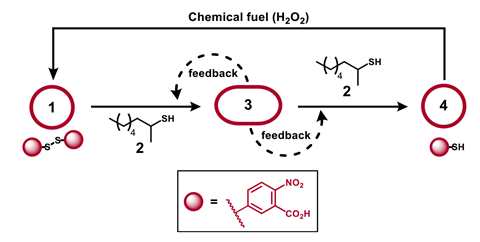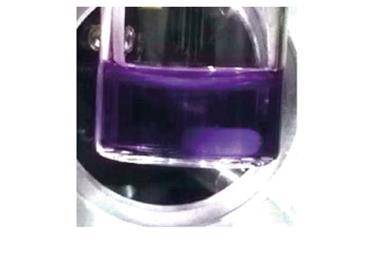Chemical ‘waves’ can be used to encode information in a similar way to radio waves. The team behind the work, led by Stephen Fletcher from the University of Oxford, developed a controllable reaction network capable of sustained oscillations and then used it to tune the shapes of chemical waves for data transduction.1 ‘We achieved this by measuring waves of chemical concentration and seeing how different input parameters give different repeating waveforms,’ explains first author Michael Howlett. The researchers believe that their new concept could one day be part of technology that is integrated with biological systems and could be included in sensors and other devices.

Reactions that produce chemical waves are very rare and challenging to design, but scientists have long been intrigued by such oscillating processes. Although chemical oscillators based on inorganic redox processes like the Belousov-Zhabotinsky (BZ) reaction have been explored for potential use in molecular communication, information transduction in chemical waves has never been shown before, points out Howlett. ‘To effectively encode information, you need reliable, periodic waves, but also a high degree of controllability,’ he says. ‘A special property of our reaction system is that it’s very responsive to experimental changes, but not intolerant of them, which would make the waves unstable.’
Using an oscillator that they developed in 2022 as the starting point,2 the team set out to identify variables that would allow them to produce waves of different amplitudes and frequencies. The new chemically fuelled system has a metabolic reaction network at its core and is centred around thiol–disulfide chemistry. The researchers found that both the rate that hydrogen peroxide (fuel) was injected and the rate of stirring could be used to control the waveforms. ‘This enabled us to produce a whole spectrum of chemical wave types,’ notes Howlett.

The chemical waves were generated in traditional round bottom flasks with reactants mixed by a magnetic stirring plate. ‘When all of the reactants had been added, the chemical waves began,’ says Howlett. ‘This was monitored by manually taking regular samples and measuring the chemical concentrations by liquid chromatography. A plot of these chemical concentrations shows waves and these waves were assigned meaning, such as a letter.’
The scientists managed to communicate using recognisable formats such as Morse code and nucleic acid sequences. To encode a word in Morse code, they carried out a single, continuous reaction where oscillating waveforms were produced over multiple hours. ‘We initially found reaction conditions which produced two distinct wave types and ran a chemical reaction where we switched between these conditions with precise timing,’ explains Howlett. ‘Measuring the chemical concentrations produced a pattern of waves which could be translated by Morse code into a word.’ In a similar experiment, they simulated RNA-like instructions, assigning each waveform to a nucleobase. ‘This demonstrates that with access to a wide range of waveforms, you can encode much higher levels of information,’ says Howlett.
Wilhelm Huck from Radboud University Nijmegen in the Netherlands, who wasn’t involved in the study, is impressed by the work. ‘One of the key results – I would say real breakthrough and surprising finding – is that the authors developed a chemical system which shows oscillations in batch,’ he says. ‘This is very unusual, if not unique, for such small systems with just a few feedback loops. The system also appears quite robust, as oscillations persist when experimental conditions are varied. As the periodicity of the oscillations depends on those parameters, it is possible to tune the waveforms, and that’s the basis of the concept of information transduction.’
Huck believes that this approach could one day be used to influence the properties of materials or living cells, but the system is still not optimised for practical applications and some problems must be addressed first. Howlett says that the main limitation is the manual sampling of the reactions, which limits the throughput.
References
1 MG Howlett et al, Chem, 2024, DOI: 10.1016/j.chempr.2024.05.010
2 MG Howlett et al, Nat. Chem., 2022, 14, 805 (DOI: 10.1038/s41557-022-00949-6)












No comments yet